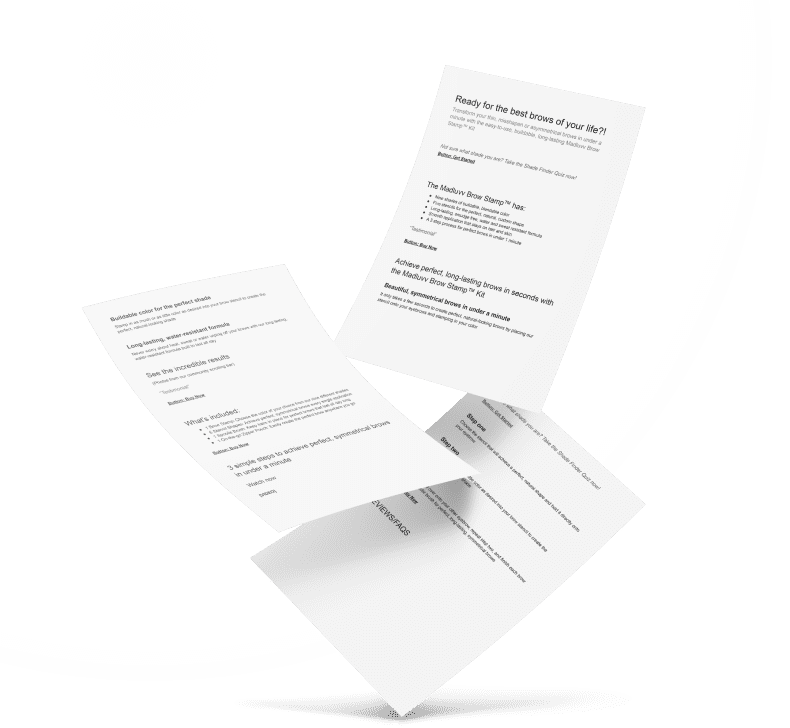



MADLUVV began looking for ways to increase sales and conversions through paid ad campaigns. In the past, MADLUVV has sent all paid traffic directly to product pages, which has resulted in a good return on investment. However, studies have indicated that landing pages can be much more effective at converting visitors, often resulting in double-digit conversion rates. Recognizing the potential for improvement, MADLUVV decided to design and curate audience-targeted landing pages for use in paid ad campaigns. The process involved thorough A/B testing using Google Optimize to refine the designs and optimize the page layout for conversions.
I wanted to understand which types of information were most likely to resonate with our customers, so I ran a 3-variant A/B test using Google Optimize. The results showed that variant 3, which alternated between influential and informational content, was the highest converting page.
The landing page showed a higher conversion rate, often resulting in double-digit conversion rates, compared to the product pages. Moving forward, I plan to continue conducting A/B tests to fine-tune the landing page and maximize its converting potential. The results of this landing page will also guide my decision making for future paid landing pages, as I can use the data to understand what works and what doesn't in driving better results for our paid advertising campaigns.





MADLUVV began looking for ways to increase sales and conversions through paid ad campaigns. In the past, MADLUVV has sent all paid traffic directly to product pages, which has resulted in a good return on investment. However, studies have indicated that landing pages can be much more effective at converting visitors, often resulting in double-digit conversion rates. Recognizing the potential for improvement, MADLUVV decided to design and curate audience-targeted landing pages for use in paid ad campaigns. The process involved thorough A/B testing using Google Optimize to refine the designs and optimize the page layout for conversions.
To craft a successful landing page I knew that the language used had to be compelling and persuasive. To ensure this, I collaborated closely with a professional copywriter. Together, we refined the copy to make sure it was engaging, persuasive, and in line with the overall objectives. The end result was a landing page that effectively communicated our message, making it more likely to convert visitors into paying customers.
Once the final copy for the landing page had been finalized, I started the process of creating wireframes for each of the individual sections. I designed the wireframes with a component-based approach, meaning that I broke the page down into smaller, reusable components that could be easily rearranged and modified as needed. This allowed me to create a flexible and modular layout.
Figma | Google Optimize


After completing the wireframing process, I moved on to designing the individual components of the landing page using the existing brand style guide and pattern libraries. This allowed me to create a cohesive and visually consistent design. During this stage, I labeled all of the components as either "informational" or "influential."
The informational sections contained product information and highlighted specific features, while the influential components contained social proof such as customer videos and reviews. I would use this labeling system in the next stage when it came to A/B testing.

As part of the process of creating an effective landing page, I wanted to understand which types of information were most likely to resonate with our customers. In particular, I was interested in whether customers were more interested in reading product information or looking for social proof through influencers and reviews. To find out, I ran a 3-variant A/B test using Google Optimize.
The first variant featured the informational sections stacked at the top of the page, with the influential content all at the bottom. The second variant was the reverse of the first, with the influential content at the top and the informational content at the bottom. The third variant was a hybrid layout that alternated between influential and informational content.
After several weeks of running the split test, I found that variant 3 was the highest converting option. Variant 2 was the second highest converting page. The majority of paid traffic comes from social ads, so the data aligns with the hypothesis that customers coming from a social campaign highly value social proof but are also interested in key features of the product.
To further optimize the landing page, I plan to continue conducting A/B tests to fine-tune the page and maximize its converting potential. In addition, I plan to use the results of this landing page to help guide the decision making for future paid landing pages. By understanding what works and what doesn't, we can create more effective landing pages that drive better results for our paid advertising campaigns.


